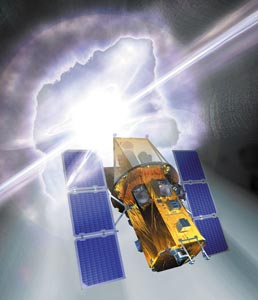
More and more astronomers are joining the race for the first optical images from gamma-ray bursts. After the precise localization of a new gamma-ray burst, several institutes try to obtain an image of its optical counterpart as quickly as possible. What makes this “sport” so exciting is that nobody knows when or where the next gamma-ray burst will occur. Luck plays an important role in the quest. Among the telescopes around the world that are ready to respond immediately to an alert, only a few are able to take advantage as the bursts occur during the night, well above the horizon and during good weather conditions.
The story of one of the most exciting of these races has recently been published in Nature (Fox et al. 2003). The starter’s shot was the detection by NASA’s High Energy Transient Explorer (HETE) satellite of a gamma-ray burst, named GRB021004, on 4 October 2002 at 12:06:14 UT. Just 193 seconds later, the Japanese Automated Response Telescope at the Institute for Physical and Chemical Research (RIKEN) pointed on the location sent out by HETE to make the first image of the burst. Sharper images were performed a few minutes later by the Near Earth Asteroid Tracking (NEAT) camera mounted on one of the Mount Palomar telescopes near San Diego, California. The fading afterglow of this burst was then followed, for several weeks, by some 40 optical telescopes around the world, as well as by six radio telescopes.
GRB021004 is the second gamma-ray burst, after GRB990123 in January 1999, to be observed in the optical less than 15 minutes after the burst. Although detected slightly later in the optical than GRB990123, it was the best-observed gamma-ray burst at that time. Now, however, all the attention is focused on GRB030329, which is on the way to take the lead over GRB021004. Detected by HETE on 29 March 2003, GRB030329 is one of the brightest and closest gamma-ray bursts on record. With a cosmological redshift of z = 0.17, it is approximately two billion light-years away, as opposed to other bursts such as GRB021004 (z = 2.32) that are located at more than 10 billion light-years away.

The unprecedented number of observations of these two recent gamma-ray bursts has tended to confirm their association with supernovae. The violent flash of gamma rays is thought to arise from ultra-relativistic particles thrown out by a cataclysmic event such as the collapse of a massive star – for example in the “cannonball” model. Such models apply to gamma-ray bursts lasting several seconds; bursts shorter than about 2 seconds are thought to be due to the coalescence of two neutron stars to form a black hole.
Currently, two satellites are able to provide and distribute accurate burst locations within seconds – HETE and INTEGRAL. In December 2003, NASA will launch the Swift spacecraft, which will have an even greater capability to detect and locate bursts, as well as on-board optical, ultraviolet and X-ray telescopes.
Further reading
D W Fox et al. 2003 Nature 422 284.








